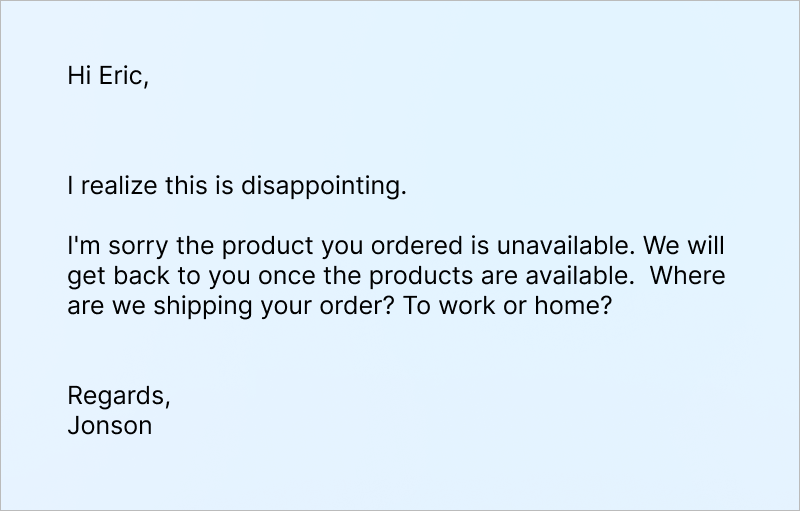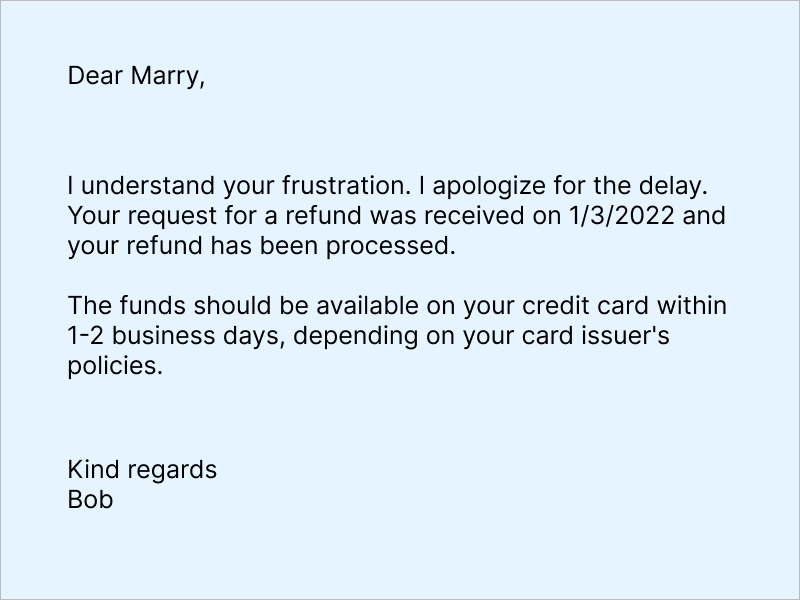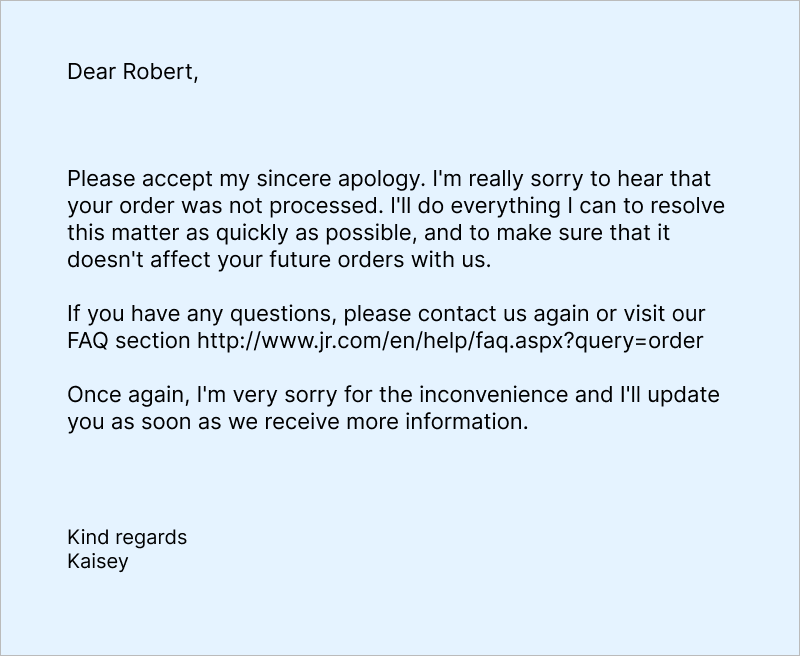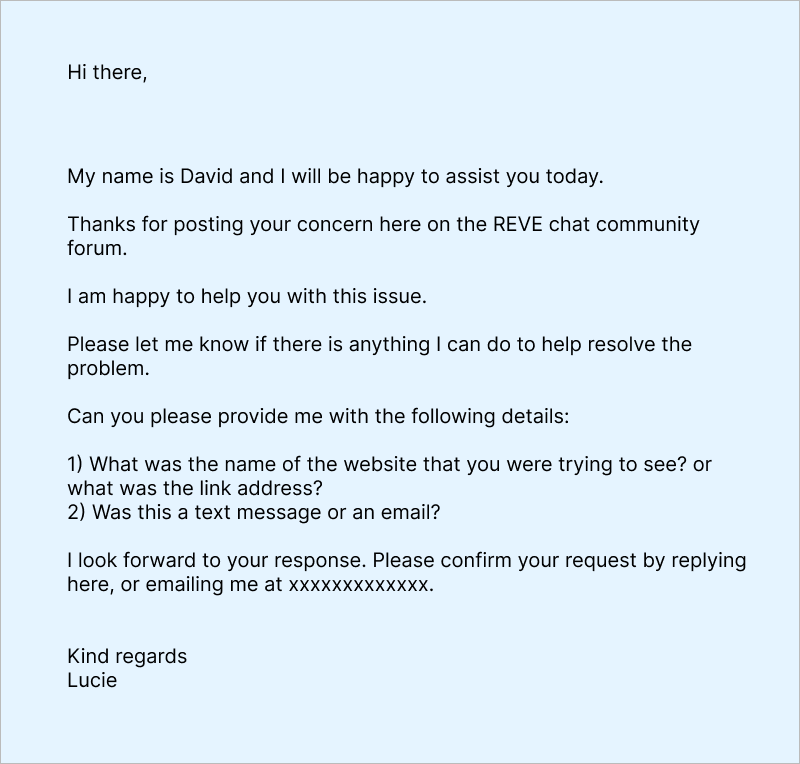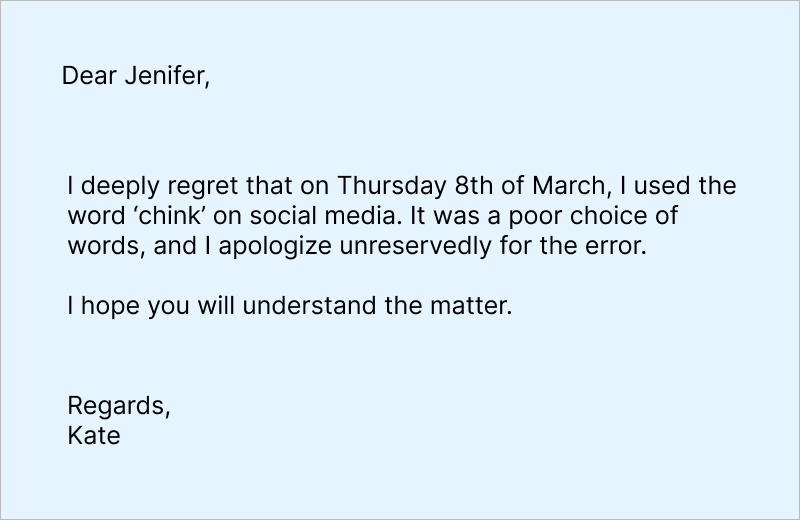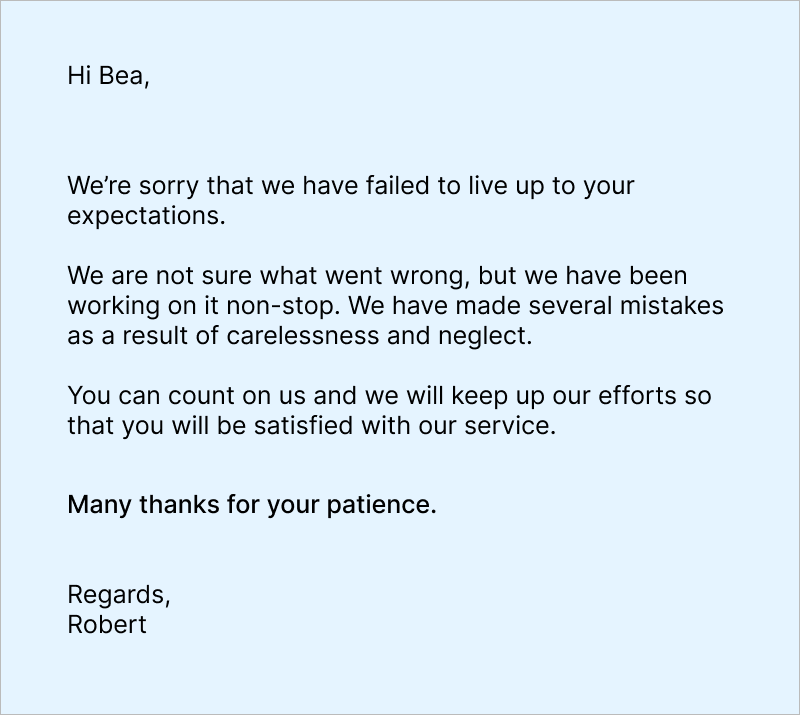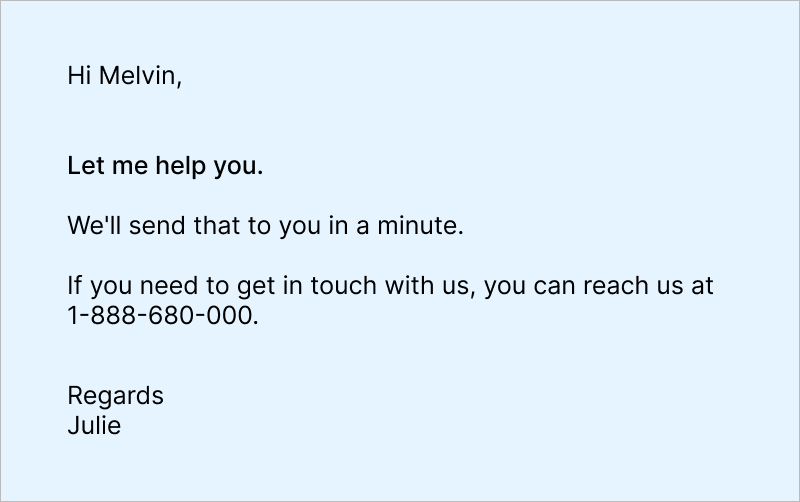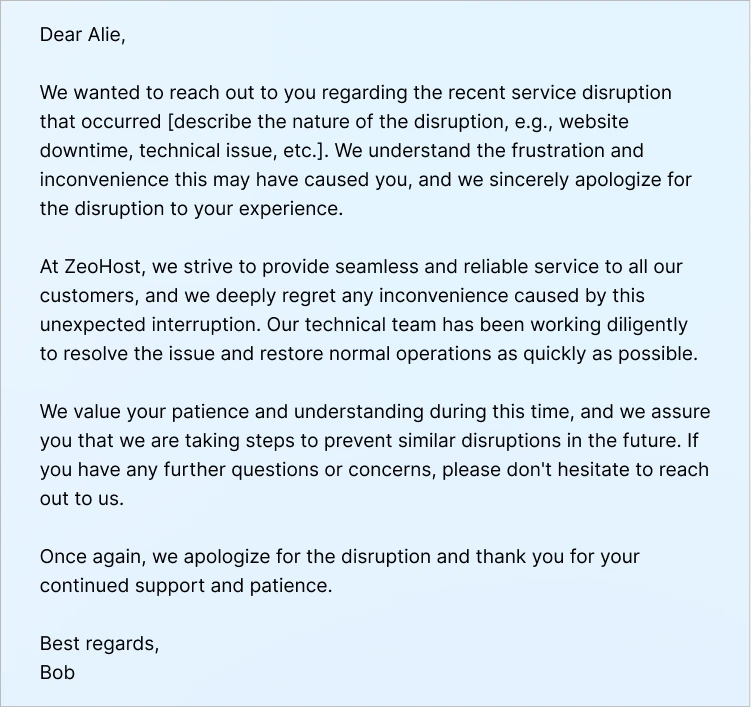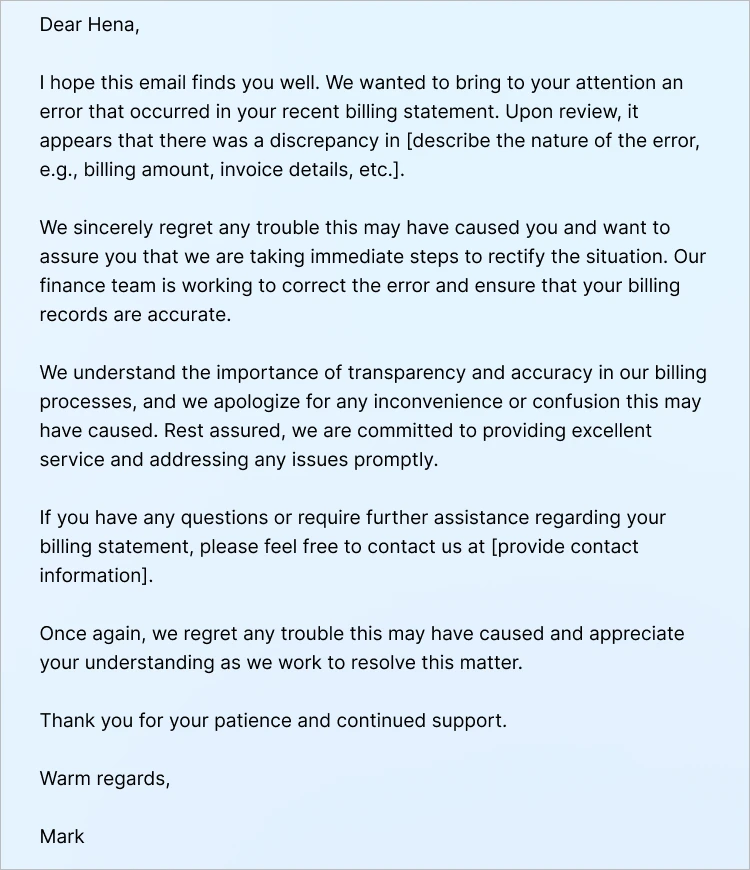A sincere apology can save you from losing your customers. You will be able to salvage your relationship with them by expressing regret and apologizing. Effective communication with your clients is very important in building trust and having a good relationship with them.
Apologizing to a customer when they are right gives them a feeling that they are important and you value their business. When you’re apologizing, it’s important to apologize sincerely without making excuses because it will leave a good impression on your customers.
When you respond to a customer, it is almost guaranteed that they will not have read your mind as to what would have been the ideal response.
Regardless of how much time you’ve spent thinking about an ideal response, you still can’t beat what happens when someone tells you that your response was perfect.
In this article, we will discuss 11 sorry for the inconvenience alternatives, examples, and templates.
What is Meant by Sorry for the Inconvenience?
“Sorry for the inconvenience” is a common phrase used by the customer support team.
It is kind of like saying, “Oops, my bad” when something goes wrong or doesn’t go as planned. It’s a way of acknowledging that there’s been a hiccup or a bump in the road that might have caused a bit of trouble or hassle for someone else.
It’s a polite way of saying, “Hey, I realize this wasn’t ideal, and I genuinely regret any trouble it may have caused you.” So, it’s like a little apology wrapped up in understanding that things didn’t go smoothly.
Although it is most often used to express regret over a delayed or missed delivery, it can also be used to apologize for any errors or mistakes that were made during a customer support call.
However, some customers will feel that it is the expression of the airline’s sincerity and apology.
Similarly, from a passenger’s point of view, he/she may believe that what he/she received was only an apology, but no compensation and relevant explanations, resulting in an unsatisfactory answer.
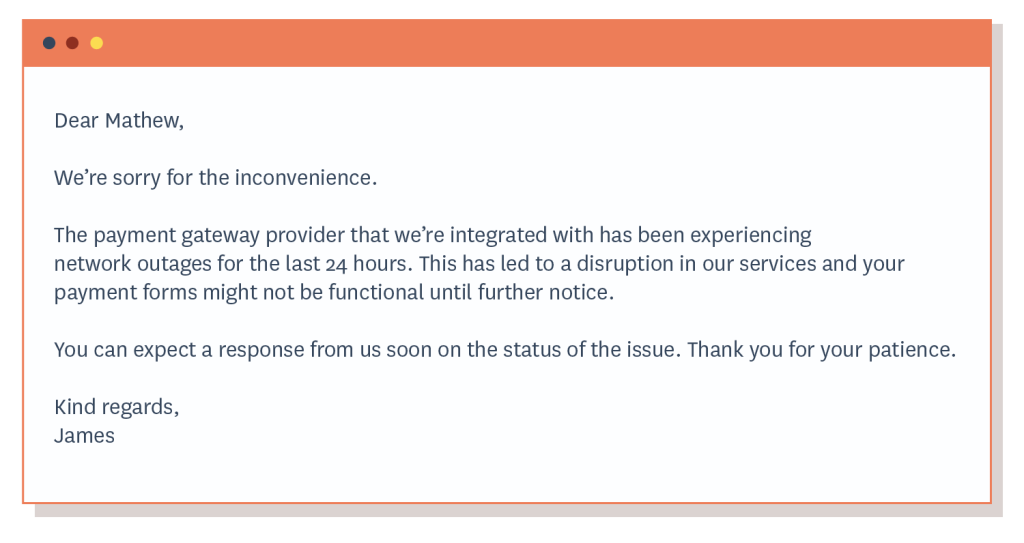
Second, if there really were problems on our side and we have wronged customers, we need to do more than make excuses.
Why Customers Don’t Like the Phrase ‘Sorry for the Inconvenience’?
“Sorry for the inconvenience” is a phrase we hear time and time again when things go wrong. But according to a new study, the phrase may actually be driving customers away.
The study found that only two out of five people were satisfied with businesses that apologized for inconveniences. It also found that half of all customers were likely to spread bad word-of-mouth about a company after an apology, and over a third of customers would rather see businesses do nothing at all than say sorry for the inconvenience.
A spokesperson for Boomerang Commerce, the company behind the study, said: “To many customers, ‘sorry for the inconvenience’ feels like a cop-out or an excuse.”
- Low authenticity – The truth is that these phrases don’t mean anything to the customers. If you do something really bad, apologize. But don’t just say sorry for the inconvenience, because it means nothing to your customer.
- Unempathetic meaning – You know how you feel when you get these words at a company. The main reason for these words is for the company’s benefit. The company uses this word so people will accept a mistake and then keep doing business with the company.
- No urgency – Customers want you to own up to your mistakes and fix them – not pretend the issue never happened.”
Why Sincere Apology is Crucial When Things Go Wrong?
When things go wrong, offering a sincere apology is crucial for a few reasons. First off, it shows that you’re taking responsibility for what happened. Instead of brushing it off or making excuses, a sincere apology says, “Hey, I messed up, and I recognize that.” This can go a long way in building trust and credibility with the person or people affected.
Secondly, it acknowledges the inconvenience or frustration that the other person may be feeling because of the situation. You’re validating their feelings and showing that you care about their experience by showing that you understand their perspective and genuinely regret any trouble caused.
Finally, it opens the door for resolution and reconciliation. It creates an opportunity to discuss how to make things right or to prevent similar issues in the future. When you apologize sincerely, it can help defuse tension and foster a positive dialogue for moving forward.
Various Types of Inconveniences in Business
In business, inconveniences can come in various shapes and sizes, and they can impact both customers and internal operations. Here are some common types of inconveniences in business:
- Service Delays: This occurs when there are delays in providing products or services to customers. It could be due to logistical issues, production delays, or unexpected disruptions in the supply chain.
- Product Defects or Quality Issues: Your customers may experience inconvenience if they receive products that are defective, damaged, or fail to meet their quality expectations. This can lead to returns, replacements, or repairs, causing frustration for both customers and businesses.
- Technical Problems: Businesses may encounter inconveniences due to technical issues with their systems, software, or equipment. This could result in downtime, disruptions to operations, and difficulties in serving customers effectively.
- Billing or Payment Errors: Inaccuracies in billing or payment processes can cause inconvenience for customers, leading to disputes, late fees, and dissatisfaction. It can also create administrative burdens for businesses to rectify the errors.
- Customer Service Failures: Poor customer service experiences, such as unresponsive support, rude staff, or ineffective problem resolution, can result in inconvenience and dissatisfaction for customers. This can damage your reputation and lead to customer churn.
- Supply Chain Disruptions: Your businesses may face inconveniences due to disruptions in the supply chain, such as natural disasters, transportation issues, or geopolitical events. This can affect the availability of raw materials, inventory levels, and fulfillment capabilities.
- Regulatory Compliance Challenges: Compliance with regulations and legal requirements can pose challenges and inconveniences for businesses. Especially, if they involve complex processes, changes in legislation, or hefty fines for non-compliance.
- Employee Absences or Turnover: Staffing issues, such as unexpected absences or high turnover rates, can disrupt operations, affect service levels, and require additional resources for hiring and training replacement employees.
Tips for Effective Apologies
Effective apologies can help repair relationships, rebuild trust, and mitigate the impact of mistakes or inconveniences. Here are some tips for crafting sincere and impactful apologies:
- Be Genuine and Sincere: You need to apologize from the heart. You can express genuine regret for the inconvenience or harm caused. Avoid insincerity or making excuses, as authenticity is key to a meaningful apology.
- Take Responsibility: Own up to your mistakes without shifting blame or making excuses. Acknowledge your role in the situation and accept accountability for any errors or shortcomings.
- Express Empathy: Show empathy and understanding towards the affected party’s feelings or perspective. You need to acknowledge the impact of your actions and validate their emotions. Demonstrating empathy can help validate their experience and foster a sense of connection.
- Offer a Clear Explanation: You should provide a brief explanation of what went wrong, if appropriate. Transparency can help the affected party understand the context of the situation and feel reassured that steps are being taken to address the issue.
- Provide a Solution: Offer a tangible solution or plan to rectify the situation and prevent similar issues in the future. Whether it’s a refund, replacement, or corrective action, demonstrating a commitment to making things right can instill confidence and trust.
- Listen Actively: Be open to feedback and actively listen to the affected party’s concerns or grievances. You should allow them to express their feelings and perspectives without interruption. Demonstrating empathy and understanding can validate their experience and pave the way for resolution.
- Follow-Up: After apologizing, follow up with the affected party to ensure that the issue has been resolved satisfactorily. Reiterate your commitment to addressing their concerns and maintaining a positive relationship. Follow-through demonstrates accountability and reinforces your sincerity.
11 Great “Sorry for the Inconvenience Alternatives”
Customer service can be hard, but we think it doesn’t have to be. That’s why we’re happy to introduce the best 7 sorry for the inconvenience and alternatives to deliver better customer service.
- I Realize This Is Disappointing
- I Understand Your Frustration
- Please Accept My Sincere Apology
- Please Let Me Know If There Is Anything I Can Do
- I Apologize Unreservedly
- Thanks for Your Patience
- Let Me Help
- I Apologize for Any Inconvenience This May Cause and Appreciate Your Understanding
- We Sincerely Apologize for the Inconvenience Caused
- We Apologize for the Disruption
- We Regret Any Trouble This May Have Caused
1. I Realize This Is Disappointing
You should recognize the customer’s disappointment faster and take ownership of the mistake. Put yourself in the customer’s shoes and make them realize that you are thinking of their perspective. Be a good listener and focus on customer sentiment. If a customer goes through disappointment just say I realize this is disappointing, but I am here to help you the best way possible.
Template:
According to a recent report by the American Customer Satisfaction Index, 75% of customers are unsatisfied with the customer service they receive.
“I realize this is disappointing” is a much better alternative to “Sorry for the inconvenience”.
Pro Tip
- Make sure your customer acknowledges that you are aware of your faults and aim to fix things. It will grow confidence and build trust in the relationship.
- Making customers feel heard is important. There is no doubt that we all feel that we are special. No matter whether your customer complaints are common or not, take some time to make your customers feel heard.
2. I Understand Your Frustration
It is needless to say sometimes your products or services are not suitable for every customer. However, it is very common and there is nothing wrong with it.
If a customer is frustrated with the product or any service and asks for a refund it doesn’t mean that you should treat the customer differently. Communicate with the customer with respect. Who knows you are going to regain the customer down the line.
Template:
If you are a customer service representative, don’t dismiss the customer complaint just by saying ‘’sorry for the inconvenience’’.
You should go through what customers are feeling and accept the blame. It will help to retain more customers and create a loyal customer base.
Pro Tip
- When you will say I understand your frustration then the customer will acknowledge that you are also feeling empathy for the situation.
3. Please Accept My Sincere Apology
“Please accept my sincere apology” is a phrase that a customer service agent can use to ask for an apology when a customer experiences delays getting any service or products from your company or brand. However, to do it, they have to understand how to embrace the right tone.
Template:
- Ignorance – customers don’t like delays. Because they feel they are being ignored or their problem isn’t important. This can happen when a customer makes a complaint or inquiry.
- Negative experience – the delay is the feeling of time spent unpleasantly. It is a subjective experience. It is not an objective one. So, make sure your customers are not experiencing any delays.
Pro Tip
- It’s important for the customer service team to always be responsive and to acknowledge mistakes quickly. If a company is not taking an active role in acknowledging problems, people will not trust the company any longer.
- Frustrated customers can be extreme or aggressive. Probably, because they have no idea that someone is listening to them. Before responding, make sure you are giving some time yourself to understand how are you feeling, too.
4. Please Let Me Know If There Is Anything I Can Do
It is another great alternative you can use instead of sorry for the inconvenience.
When you are communicating with a customer to provide assistance. You can say simply ‘’Please let me know if there is anything I can do to help resolve the problem’’. This phrase shows your willingness to support the customer.
Template:
Pro Tip
- There is a lot of competition out there, and people are happy to pick a product with better customer service. Worse yet, unhappy customers can easily rant and rave online, resulting in bad reviews and social media, dragging you down further. Make sure you are assisting your customer always.
5. I Apologize Unreservedly
The most important thing is to make sure your customers feel like they have been heard.
Additionally, it is good to know that saying this phrase will resolve the situation faster than a regular apology because it comes from a place of sincerity.
Template:
You just can’t make the customer happy just by saying sorry for the inconvenience to address all uncaring and flippant.
However, if you have made an error of judgment which resulted in someone serious offense or inconvenience then you can say ‘’I apologize unreservedly’’.
6. Thank You for Your Patience
On the surface, customer service is often a light-hearted affair, but underneath that, it’s a serious business. A little can make or break the relationship with the customers. Treating the customer with respect and value is crucial for any business.
Template:
In fact, in many ways, it’s one of the most difficult tasks you could undertake. That’s because customer service is like an iceberg; nine-tenths of it is underwater, and you can’t see it unless you’re in the business or sitting in a chair.
Pro Tip
- There is no doubt that some people don’t like the apology they need to solve the issues that caused inconvenience. In these cases, you can say something that is not trite, however, also free from an unnecessary apology.
7. Let Me Help
People ask for help when they are disappointed. Instead of showing an apology, offer them help. This is what they are looking for from you.
Let me help – is a phrase that literally means – let me assist you. It sounds very polite.
It’s worth mentioning, that it does not matter what kind of work you do, or what kind of company you work for, saying the phrase ”let me help” can always be useful.
Template:
But before we look at examples of how to use it − let’s think about the reasons for using this phrase?
The first and most important reason for using this phrase is to make an impression on your audience or customer. You can make them feel that you are a sincere and attentive person.
By saying ”let me help”, you show that you are willing to assist your customer.
- Provide a simple solution – Have you ever spent hours on the way to solve a problem and found the solution? You will never forget what you went through when you looked for that answer. Make sure your customers can find answers quickly and easily.
- Assist customers when they need it – customers sometimes have difficulties when shopping online. Some do not know how to find answers to their problems, and some do not know how to ask for help. These customers who need assistance are your priority.
8. I Apologize for Any Inconvenience This May Cause and Appreciate Your Understanding
The phrase “I apologize for any inconvenience this may cause and appreciate your understanding” is commonly used in situations where a person or organization needs to inform someone about a potential inconvenience or disruption to their plans, and they want to express their regret while seeking the recipient’s understanding.
It is often used in emails, letters, or other forms of communication to acknowledge the inconvenience and show appreciation for the recipient’s patience and understanding.
Template:
|
Dear Joe, I hope this email finds you well. I am writing to inform you about a temporary service disruption that may affect your upcoming visit to our establishment. Due to unforeseen circumstances, we have encountered an issue with our electrical system that requires immediate attention. As a result, we will need to temporarily suspend our services for the next two days while our team resolves the problem. We understand that this may cause inconvenience to your planned visit, and we sincerely apologize for any inconvenience this may cause. We sincerely apologize for any inconvenience this may cause and appreciate your understanding in this matter. We look forward to welcoming you back soon to enjoy our services. Thank you for your continued support. Best regards, |
|
9. We Sincerely Apologize for the Inconvenience Caused
The phrase “We sincerely apologize for the inconvenience caused” is commonly used when a person or organization wants to express genuine regret for an inconvenience that has been caused to someone. It is typically used in situations where there has been an error, mistake, delay, or any other unforeseen circumstance that has resulted in inconvenience for the recipient.
This phrase is often used in emails, letters, or other forms of communication to acknowledge the inconvenience and offer an apology.
Template:
10. “We Apologize for the Disruption”
You’re cruising along, minding your own business, and then bam! Something unexpected happens, throwing a wrench in your plans. It could be a website crash, a sudden service outage, or a glitch in the system. You’re left scratching your head, wondering what went wrong.
Now, imagine receiving an email from the company responsible for the hiccup. It starts with a simple yet powerful line: “We apologize for the disruption.” It’s like a virtual hand reaching out, acknowledging the chaos, and saying, “Hey, we see what happened, and we’re sorry for the hassle it caused you.”
This phrase acknowledges the disruption caused by the inconvenience while expressing a sincere apology. It conveys empathy and recognizes the impact on the affected party’s experience.
Template:
Pro Tip
- When using this phrase, it’s important to acknowledge the specific impact of the disruption on the affected party. Whether it’s a website crash, a service outage, or a logistical delay, recognizing the inconvenience helps validate the customer’s experience.
11. “We Regret Any Trouble This May Have Caused”
Just think a minute, you’re opening an email from a company you’ve been dealing with, expecting smooth sailing, only to discover a hiccup in the process. Maybe it’s a billing error, a shipping delay, or a miscommunication that’s thrown a wrench in your plans. As you read through the email, you come across a line that stands out: “We regret any trouble this may have caused.” It’s like a virtual hand extended, acknowledging the inconvenience you’ve experienced and expressing genuine regret for the hassle.
This phrase communicates regret for any inconvenience or difficulty experienced by the affected party. It demonstrates accountability and a commitment to addressing the situation effectively.
Template:
Pro Tip:
Show genuine empathy for the inconvenience or trouble experienced by the affected party. Acknowledge the frustration or inconvenience they may have encountered and convey an understanding of their perspective. A heartfelt expression of empathy helps validate the customer’s feelings and fosters a sense of connection.
How REVE Chat Can Assist You in Handle Customer Complaints?
In the current era of massive automation and artificial intelligence (AI), customers are increasingly turning to chatbots for assistance with their complaints.
As a matter of fact, consumers want to find quick solutions. They don’t want to spend hours on the phone or finding the best contact information for a particular brand only to be told that the company does not offer any refunds or compensation for poor services.
REVE Chat can assist with an efficient solution on their terms in real-time. Sign Up now and enjoy 14 days free trial.


